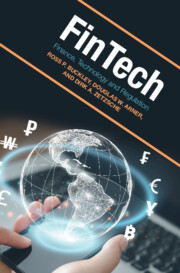Book contents
- FinTech
- FinTech
- Copyright page
- Contents
- Figures
- Acknowledgements
- Abbreviations and Technical Terms
- 1 Introduction
- Part I Digital Transformation of Finance and Regulation
- Part II Addressing the Challenges of Innovation in Finance
- Part III Building Better Financial Systems
- Part IV From FinTech to TechFin to BigTech to FinTech 4.0
- Part V Conclusion
- Index
1 - Introduction
Published online by Cambridge University Press: 09 November 2023
- FinTech
- FinTech
- Copyright page
- Contents
- Figures
- Acknowledgements
- Abbreviations and Technical Terms
- 1 Introduction
- Part I Digital Transformation of Finance and Regulation
- Part II Addressing the Challenges of Innovation in Finance
- Part III Building Better Financial Systems
- Part IV From FinTech to TechFin to BigTech to FinTech 4.0
- Part V Conclusion
- Index
Summary
FinTech, as we lay out in this book, is best understood as including four major elements: first, global wholesale markets where digitisation means speed, crucial for capitalising on information advantages; second, an explosion of financial technology (FinTech) start-ups particularly since 2008 in the aftermath of the Global Financial Crisis (GFC) seeking regulatory lenience that was available to the small but not the large; third, the unprecedented digital financial transformation in retail finance in some countries, particularly China, India, and Kenya; and fourth, the increasing role of large technology companies moving into financial services and digital financial platforms.This long-term process of digitisation and datafication of finance has increasingly combined with the technologies commonly termed ‘ABCD’: Artificial Intelligence (A), Big Data (B), Cloud Computing (C), and Distributed Ledger Technology (D). The latter typically uses blockchains and makes possible the smart contracts that underpin cryptocurrencies and central bank digital currencies. These technologies have together, on the one hand, prompted the need for digital identification and, on the other hand, triggered the extraordinary growth we have seen: Regulatory Technologies (RegTech) and Supervisory Technologies (SupTech).We include all of these aspects of the revolution through which we are all living in the rubric, FinTech. Its ambit is broad and extends from innovations with disruptive effects on existing intermediaries, such as crowdfunding and crowdlending among many others, through to the entry into financial services of the BigTechs and the existential threats they pose to traditional banks.
Keywords
Information
- Type
- Chapter
- Information
- FinTechFinance, Technology and Regulation, pp. 1 - 8Publisher: Cambridge University PressPrint publication year: 2023
